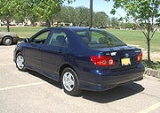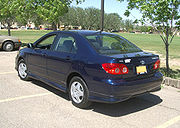
Durable good
Encyclopedia

Economics
Economics is the social science that analyzes the production, distribution, and consumption of goods and services. The term economics comes from the Ancient Greek from + , hence "rules of the house"...
, a durable good or a hard good is a good that does not quickly wear out, or more specifically, one that yields utility
Utility
In economics, utility is a measure of customer satisfaction, referring to the total satisfaction received by a consumer from consuming a good or service....
over time rather than being completely consumed
Consumption (economics)
Consumption is a common concept in economics, and gives rise to derived concepts such as consumer debt. Generally, consumption is defined in part by comparison to production. But the precise definition can vary because different schools of economists define production quite differently...
in one use. Items like brick
Brick
A brick is a block of ceramic material used in masonry construction, usually laid using various kinds of mortar. It has been regarded as one of the longest lasting and strongest building materials used throughout history.-History:...
s or jewellery
Jewellery
Jewellery or jewelry is a form of personal adornment, such as brooches, rings, necklaces, earrings, and bracelets.With some exceptions, such as medical alert bracelets or military dog tags, jewellery normally differs from other items of personal adornment in that it has no other purpose than to...
could be considered perfectly durable goods, because they should theoretically never wear out. Highly durable goods such as refrigerator
Refrigerator
A refrigerator is a common household appliance that consists of a thermally insulated compartment and a heat pump that transfers heat from the inside of the fridge to its external environment so that the inside of the fridge is cooled to a temperature below the ambient temperature of the room...
s, car
Čar
Čar is a village in the municipality of Bujanovac, Serbia. According to the 2002 census, the town has a population of 296 people.-References:...
s, or mobile phone
Mobile phone
A mobile phone is a device which can make and receive telephone calls over a radio link whilst moving around a wide geographic area. It does so by connecting to a cellular network provided by a mobile network operator...
s usually continue to be useful for three or more years of use, so durable goods are typically characterized by long periods between successive purchases.
Examples of consumer durable goods include cars, household goods
Household goods
Household goods are goods and products used within households. They are the tangible and movable personal property placed in the living rooms, dining rooms, kitchens, family rooms, great rooms, bedrooms, bathrooms, recreation rooms, hallways, attics, and basements and other rooms of a...
(home appliance
Home appliance
Home appliances are electrical/mechanical machines which accomplish some household functions, such as cooking or cleaning. Home appliances can be classified into:*Major appliances, or White goods*Small appliances, or Brown goods...
s, consumer electronics
Consumer electronics
Consumer electronics are electronic equipment intended for everyday use, most often in entertainment, communications and office productivity. Radio broadcasting in the early 20th century brought the first major consumer product, the broadcast receiver...
, furniture
Furniture
Furniture is the mass noun for the movable objects intended to support various human activities such as seating and sleeping in beds, to hold objects at a convenient height for work using horizontal surfaces above the ground, or to store things...
, etc.), sports equipment
Sports equipment
Sports equipment is a general term for any object used for sport or exercise. Examples of sports equipment include:-Exercise equipment:Examples for exercise include swiss balls, weights, equipment for the gym...
, and toy
Toy
A toy is any object that can be used for play. Toys are associated commonly with children and pets. Playing with toys is often thought to be an enjoyable means of training the young for life in human society. Different materials are used to make toys enjoyable and cuddly to both young and old...
s.
Nondurable goods or soft goods (consumables) are the opposite of durable goods. They may be defined either as goods that are immediately consumed in one use or ones that have a lifespan of less than 3 years.
Examples of nondurable goods include fast moving consumer goods
Fast Moving Consumer Goods
Fast moving consumer goods or Consumer Packaged Goods are products that are sold quickly and at relatively low cost. Examples include non-durable goods such as soft drinks, toiletries, and grocery items...
such as cosmetics
Cosmetics
Cosmetics are substances used to enhance the appearance or odor of the human body. Cosmetics include skin-care creams, lotions, powders, perfumes, lipsticks, fingernail and toe nail polish, eye and facial makeup, towelettes, permanent waves, colored contact lenses, hair colors, hair sprays and...
and cleaning products, food, fuel, office supplies, packaging and containers, paper and paper products, personal products, rubber, plastics, textiles, clothing and footwear.
While durable goods can usually be rented as well as bought, nondurable goods can generally not be rented. While buying Durable goods comes under the category of Investment demand of Goods, buying Non-Durables comes under the category of Consumption demand of Goods.
See also
- Industrial organizationIndustrial organizationIndustrial organization is the field of economics that builds on the theory of the firm in examining the structure of, and boundaries between, firms and markets....
- Coase ConjectureCoase ConjectureThe Coase conjecture, developed first by Ronald Coase, is an argument in monopoly theory. The conjecture sets up a situation in which a monopolist sells a durable good to a market where resale is impossible and faces consumers who all have different valuations...
- Putty-puttyPutty-puttyIn economics, putty-putty describes an attribute of capital in financial models. Putty-putty capital can be transformed from flexible capital into durable goods then back again. This contrasts with putty-clay capital which can be converted from flexible capital into durable goods but which cannot...

